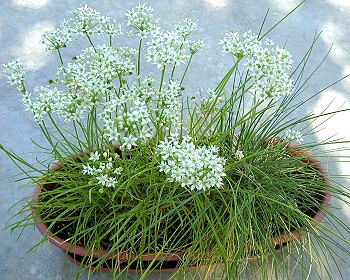Owing to the screen size of your device, you may obtain a better viewing experience by
rotating your device a quarter-turn (to get the so-called "panorama" screen view).
|
This page updated for 2022.
|
Click here for the site directory.
|
|
Please consider linking to this site!
|
Click here to email us.
|
Garlic Chives
(Allium tuberosum)
About Garlic Chives

Garlic chive is not a cultivar of ordinary chives but a distinct species of plant. It is commonly regarded as a major kitchen herb, tasting—as its name suggests—like chives with a mild addition of garlic flavor. It looks like and is grown very much like ordinary chives.
One source says that “garlic chives tends to go dormant during the winter, [so] potting for indoor use is not recommended.” Fortunately, no one told our garlic chives about that, and they go merrily along through winter growing abundantly. (We think they don’t go dormant unless the ambient temperature falls below about 40° F.)
Note that in Chinese cuisine, the flowerheads of garlic chives are considered a delicacy.
Cultivars
There are at least some recognized cultivars, though few or none are identified as such in seedsmen’s catalogues (one is a variant with pink, instead of white, flowers). You pretty much get “garlic chives” and that’s all she wrote.
Planting
Garlic chives sprout easily from seed, after which they can easily be propagated vegetatively by clump division—or you can cut the cackle and just buy a plant (they are perennials). They are said to prefer a sunny position in a rich, moist, but well-drained soil, but are also said to be quite forgiving of adverse conditions.
If you’re considering growing them in-ground, beware: they are invasive, and pulling them can become quite a tedious chore. Indoors in a pot or window tray is best.
Growing
Garlic chives generally like moist (but not soggy) soil. During their first season, hold down watering to encourage root growth.
Garlic chives tolerate heavy harvesting. You can treat it like ordinary chives, pinching off any flower buds that appear, or you can let it flower in the autumn, as the buds and flowers are every bit as tasty and edible as the leaves. Harvest leaves by cutting some, or even all, being sure though to cut close to the soil level, so the plant “knows” to send up new leaves. If your garlic chives plant seems to be getting woody, prune it all down to about an inch above the soil level.
A little balanced organic fertilizer every season would not go amiss.
It is wise to re-divide one’s garlic chives every few years, to maintain plant vigor. Division can be done almost anytime, but is probably best done in spring.
Relevant Links
Besides any links presented above on this page, the following ought to be especially helpful.
Return to the top of this page.
If you find this site interesting or useful, please link to it on your site by cutting and pasting this HTML:
The <a href="https://growingtaste.com/"><b>Growing Taste</b></a> Vegetable-Gardening Site
—Site Directory—
Search this site, or the web
-
Background Information
about the purposes and design of this site
- Site Front Page
-
Introduction

- An Apologia: why one should cultivate one's garden
- Deep-Bed Gardening (forthcoming)
- Container Gardening (forthcoming)
- Vegetarian and Organic Considerations (forthcoming)
-
Recommended Crops for a home garden, by variety
-
Gardening information and aids
-
Miscellaneous Information of interest to the home gardener
Since you're growing your own vegetables and fruits, shouldn't you be cooking them in the best way possible?
Visit The Induction Site to find out what that best way is!
|
If you like good-tasting food, perhaps you are interested in good-tasting wines as well?
Visit That Useful Wine Site for advice and recommendations for both novices and experts.
|

|
This site is one of The Owlcroft Company family of web sites. Please click on the link (or the owl)
to see a menu of our other diverse user-friendly, helpful sites.
|
|
 Like all our sites, this one is hosted at the highly regarded Pair Networks,
whom we strongly recommend. We invite you to click on the Pair link for more information on getting your site or sites hosted on a first-class service.
Like all our sites, this one is hosted at the highly regarded Pair Networks,
whom we strongly recommend. We invite you to click on the Pair link for more information on getting your site or sites hosted on a first-class service.
|
|
All Owlcroft systems run on Ubuntu Linux and we heartily recommend it to everyone—click on the link for more information.
|
Click here to send us email.
Because we believe in inter-operability, we have taken the trouble to assure that
this web page is 100% compliant with the World Wide Web Consortium's
XHTML Protocol v1.0 (Transitional).
You can click on the logo below to test this page!
You loaded this page on
Monday, 31 March 2025, at 14:18 EDT.
It was last modified on Monday, 10 January 2022, at 05:24 EST.
All content copyright ©1999 - 2025 by
The Owlcroft Company

